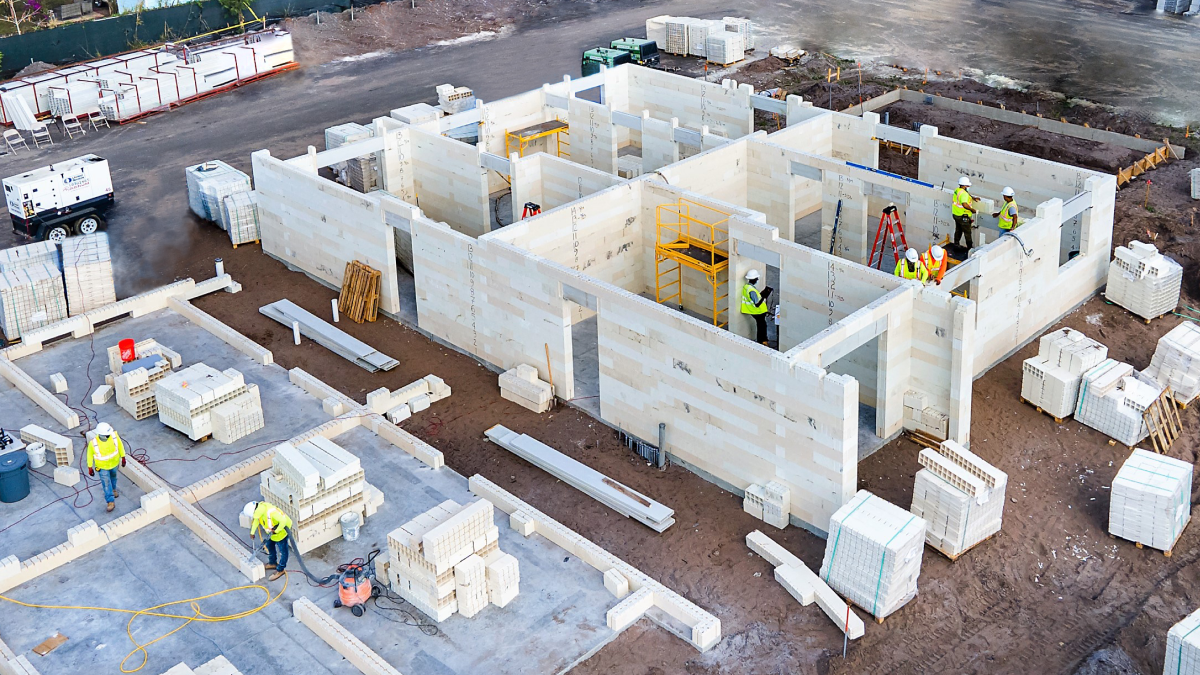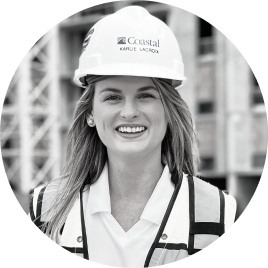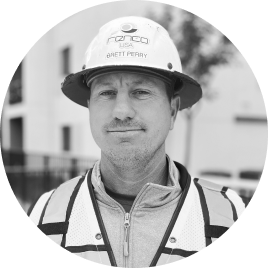05.13. 2024 | For Construction Pros
RENCO's Structural Building System — Building Blocks of the Future

As a kid, building with blocks was fun and relatively simple. The construction industry could use an easier and more sustainable way to build infrastructure and RENCO has a solution.
As children, many of us played with LEGOs, and some of us may still play with the famous colorful bricks from time to time. Now, there is a real-world LEGO-like building block that can be used in construction. RENCO has come out with an easier and more sustainable way of building. The convenience and simplicity of LEGO building is becoming a reality with the RENCO Structural Building System.
About the RENCO Structural Building System
Inspired by Turkish American businessman and Co-founder, Engin Yesil, RENCO developed its mineral composite fiber-reinforced product. RENCO came to exist in Florida in the year 2012. Over nearly eight years, the company’s system had to go through many tests before it could be approved for use.
The first round of testing consisted of subjecting the material to different stresses such as heat, freeze, and thaw. This testing took three years on its own. “Once that was done, we attained achievable and great results for our tensile and compressive flexural strength of the material,” says Ken Smuts, president of RENCO.
After many years of testing to prove the quality of its building system, RENCO finally was able to map out and start a project in West Palm Beach, Fla. The company’s first project was made possible by teaming up with its affiliate contractor — Coastal Construction. Co-founder of RENCO and founder, chairman, and CEO of Coastal Construction, Thomas Murphy had a huge role in connecting the two companies and pushing the RENCO Structural Building System vision along.
Having over 300 employees, Smuts says that the Coastal Construction Group and the Murphy family have been building projects throughout Florida for over five decades and have become one of the largest general contractors in Florida. Coastal currently has operations in Miami, West Palm Beach, Naples, Orlando, Tampa, and the Florida Keys. They specialize in hospitality, single and multifamily residential, education, commercial, and mixed-use projects. In addition to many hotels and residences, the company was the primary builder for Ocean Reef Club, Deering Bay Club, Miami Design District, Miami Worldcenter, and Water Street Tampa.
RENCO has proven to the world just how ingenious its ideas for building and construction are and has won a few awards thus far. In November of 2023, the company and its building system won a global award for Best Construction Product Design for 2023. In February of 2024, the company won first place in the 2024 JEC Composites Innovation Awards. These awards are evidence of the impressive building innovations that the RENCO Structural Building System represents for sustainability.
Sustainability
The RENCO name is short for “renewable composite,” which represents much of what the company is about. The RENCO Structural Building System’s blocks are made from a mix of materials including:
- Recycled glass fibers
- Recycled plastic
- Resin
- Stone
Smuts says, “We’re here to … educate as we’re trying to change people’s paradigm from building with conventional wood, steel, and concrete to something … more sustainable that can put a workforce to work that’s generally not skilled to be doing things like this.”
Along with being more sustainable, the blocks are creating job opportunities for people who would normally never find themselves building houses and other structures because they aren’t specialized to do so. This in turn is working to fight the continuing labor shortage.
The RENCO Structural Building System has a straightforward building pattern and the blocks are very lightweight.
“A concrete block weighs about 37 lbs when it’s dried out. Our blocks weigh 8 1/2 lbs. They’re about 20% the weight of a concrete block. Anybody can lift these things up and put them in place,” reveals Smuts.
The blocks are quite easy to place, making it much easier for the company to find and support crews to build using its product. The overall sustainability of RENCO’s Building System comes from recycled and easy-to-source materials and the ease with which the company can continue to maintain and supply its product.
Savings in Cost & Time
Using recycled materials in the Building System has proven to be useful when it comes to the price of making, selling, and building using the blocks.
Smuts explains, “There’s a value savings here that we’re offering, in addition to the sustainability and the overall longevity and durability of the product.”
A typical product would generally be delivered and installed for around $40 per square ft. whereas RENCO’s only costs about $30 per square ft. This is a significant money savings for the same or better quality and durability.
The number of workers needed for construction projects done with the RENCO blocks is far less than that needed for normal concrete construction. “We used two crews of four and then we had a couple of laborers and an equipment operator. So the gang on site was about 11 people,” says Smuts. “The laborers are there to help unload pallets and remove the pallets when they’re done — just general cleanup and overall labor.”
With RENCO only needing teams of four to build its structures with the addition of only around three people to do general labor, it can save a lot of money. But in addition to the money saved, RENCO also saves time. There is time saved throughout the whole process because of how simple and straightforward the building method is. Smuts explains that the first construction project that the company did took about eight weeks and only needed 11 workers. In comparison, he says if the same project had been done in concrete, it would have taken about three months to be completed and would have needed 50-plus workers.
Resisting the Elements
After going through the basics of structural testing and connection testing, the system was put to the test against a variety of environmental factors. “We achieved one and two-hour fire ratings with our material depending on the type of assembly we’re building,” Smuts states.
Fire testing is a huge part of the environmental testing that is required. Construction teams need to be sure that the product they’re building with is resistant to fire to protect the structure that they’ve built, but also to make sure it isn’t a safety risk to the people who will use it or live in it. The popularly used concrete block is fire-resistant which makes it appealing to contractors and construction companies as it provides a component of safety. But, fire isn’t the only thing that can cause safety risks.
Smuts continues, “We’ve done termite testing on this, we’ve done UV conditioning, we’ve completed all kinds of thermal testing and acoustical testing.”
The RENCO Structural Building System went through over 400 tests in 27 different states. After getting licensed to use the Building System, RENCO built a 100-unit apartment complex in West Palm Beach, Fla. Being in Florida, the area is susceptible to hurricanes and high winds. A Category 5 hurricane is characterized by 157 mph wind or higher.
Smuts says, “It’s in a 170 mph wind zone … and we can resist the forces of a Category 5 hurricane.”
The system’s ability to withstand such a destructive tropical storm makes it an impressive option for many different places across the nation.
Insulation Solution
When it comes to the ability to keep the RENCO Structural Building System infrastructure insulated, the company has discovered a few ways of keeping up to code. While Florida’s required R-value is on the lower end compared to some of the colder states, RENCO has solutions and the breakdown of how the blocks are insulated is quite simple.
“A concrete block has an R-value of 1.1. Our block has an R-value of 2.2 because of the cells in the airspace. When you combine that with foil insulation and drywall, we achieved an R-value of 6 for the wall system when the requirement was 5.4,” says Smuts.
Smuts explained that the company has worked with other climates other than that of Florida. In these cases, they have an expanding foam that can be placed inside the blocks in the factory.
“There’s different kinds of expandable foam and the R-value for each foam is either a three or a five per inch. So, if you fill all 8 in. [of the block] with a 5-R foam, ostensibly you could get an R-value in excess of 40,” Smuts continues.
According to Smuts, folks in Alaska have requested sample houses. The company will have to experiment with its expandable foams and other insulation options to accommodate for the much higher R-value, but the company already has a pretty good idea of how it might be able to get above an R-value of 40.
Step-by-Step Building Blocks
Being a new product to the market, RENCO’s Structural Building System was limited to building construction type 5A — a five-story building. “[Five-story buildings] represent 93% of the construction throughout the entire U.S.,” Smuts says. The company is going through continued testing to prove that its product can go higher. He says that it’s mostly been fire testing and the blocks have already passed the non-combustible fire test to build to 75 ft. and higher.
“ Now we’re working on the joists and the decking system to improve our formulations so that we can pass the fire test that will allow us to build to eight stories,” Smuts says.
In a similar way to how people build with LEGOs, the RENCO blocks can be built in an overlapping method to provide added stability and durability. Smuts explains: “We call that a running bond. There are two differences. There’s a running bond, where you overlay the tops and you straddle from one block to the next, and a stack bond where you just stack blocks on top of each other. Things are much stronger when you do the running bond.”
Since the RENCO Structural Building System is made up of blocks, the methods used to build with children’s toys like wooden blocks and LEGO bricks still apply and are the same methods that continue to make the most sense. “You get one monolithic wall structure when you glue everything together the way you do. But the way you lay these blocks is really simple, so anybody can do it,” says Smuts.
RENCO presents a promising and efficient future for the construction industry. The building system opens new doors for people who never would have imagined their lives would take them to the construction field and a solution for the industry’s labor shortage.








